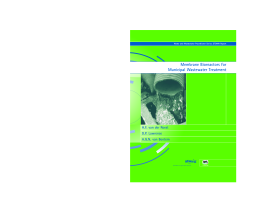
BOOK
Membrane Bioreactors for Municipal Wastewater Treatment
H. F. van der Roest | D. P. Lawrence | A. G. N. van Bentem
(2002)
Additional Information
Book Details
Abstract
Recent technical innovations and significant cost reductions have sharply increased the potential for using Membrane Bioreactor (MBR) technology in municipal wastewater treatment. MBR technology displays several advantages compared to the traditional activated sludge processes, such as high effluent quality, limited space requirement and with the possibility of a flexible and phased extension of existing waste water treatment plants. Membrane Bioreactors for Municipal Wastewater Treatment describes the results of a comparative research programme involving four leading membrane suppliers: Kubota (Japan), Mitsubishi (Japan), X-Flow (Netherlands) and Zenon (Canada). Each supplier provided a pilot to represent a suitable scale - right up to full scale. These pilots were operated and optimised in the course of the research programme to achieve the best operating window under different operating regimes. The research focussed on the functionality of the membrane, the biological treatment, membrane fouling, achieved effluent quality, and system operability as well as other factors. In a number of side studies the required pre-treatment, membrane fouling/cleaning, energy usage, effluent quality and sludge processing were also addressed. The comparative pilot research was carried out by DHV Water on location at the wastewater treatment plant at Beverwijk in the Netherlands.
Table of Contents
| Section Title | Page | Action | Price |
|---|---|---|---|
| CONTENTS | vi | ||
| Preface | viii | ||
| Summary | x | ||
| 1 Introduction | 1 | ||
| 2 Membrane bioreactor | 5 | ||
| 2.1 Introduction | 5 | ||
| 2.2 Principles and background | 6 | ||
| 2.3 Membrane terminology | 7 | ||
| 2.4 Literature | 10 | ||
| 3 Programme approach | 17 | ||
| 3.1 Introduction | 17 | ||
| 3.2 Organisational set up | 17 | ||
| 3.3 Technical set up | 18 | ||
| 3.4 Research phases | 19 | ||
| 3.5 Measuring programme and methods | 20 | ||
| 3.6 Continuation | 21 | ||
| 4 Beverwijk-Zaanstreek WWTP | 23 | ||
| 4.1 Introduction | 23 | ||
| 4.2 Configuration of Beverwijk WWTP | 23 | ||
| 4.3 Biological performance | 24 | ||
| 5 Membrane suppliers | 29 | ||
| 5.1 Introduction | 29 | ||
| 5.2 Kubota | 29 | ||
| 5.3 Mitsubishi | 31 | ||
| 5.4 X-Flow | 31 | ||
| 5.5 Zenon | 32 | ||
| 6 Kubota | 35 | ||
| 6.1 Introduction | 35 | ||
| 6.2 System configuration | 35 | ||
| 6.3 Biological performance | 37 | ||
| 6.4 Membrane performance | 42 | ||
| 6.5 Conclusions | 50 | ||
| 7 Mitsubishi | 53 | ||
| 7.1 Introduction | 53 | ||
| 7.2 System configuration | 54 | ||
| 7.3 Biological performance | 55 | ||
| 7.4 Membrane performance | 60 | ||
| 7.5 Conclusions | 66 | ||
| 8 X-Flow | 69 | ||
| 8.1 Introduction | 69 | ||
| 8.2 System configuration | 70 | ||
| 8.3 Biological performance | 72 | ||
| 8.4 Membrane performance | 77 | ||
| 8.5 Conclusions | 83 | ||
| 9 Zenon | 87 | ||
| 9.1 Introduction | 87 | ||
| 9.2 System configuration | 87 | ||
| 9.3 Biological performance | 89 | ||
| 9.4 Membrane performance of ZW500a | 94 | ||
| 9.5 Conclusions (biology and ZW500a) | 100 | ||
| 9.6 Membrane performance (ZW500c–'octopus') | 101 | ||
| 9.7 Conclusions ZW500c | 105 | ||
| 10 Side studies | 109 | ||
| 10.1 Side study 1: Pre-treatment | 109 | ||
| 10.2 Side study 2: Membrane fouling and cleaning | 111 | ||
| 10.3 Side study 3: Energy consumption /a-factor | 114 | ||
| 10.4 Side study 4: Effluent quality | 115 | ||
| 11 Evaluation | 119 | ||
| 12 Current status and perspective | 127 | ||
| 13 Reference list | 129 | ||
| 14 Glossary | 131 | ||
| 15 Appendix 1: participants | 133 | ||
| Index | 137 |
